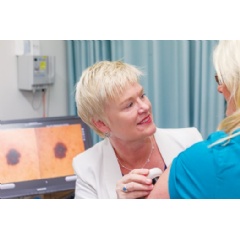Laser Skin Treatment and Melanoma
It’s vital to have your skin checked for melanoma before having your spots lasered. Cutera Medical Grade Laser can improve the appearance of sun damaged skin but will not cure skin cancer. Pigmentation or irregularities on the skin may be melanoma, basal cell carcinoma or squamous cell carcinoma and not just sun damage. These skin cancers will not be cured by Cutera Laser skin treatment, it may even make them harder to detect.

Laser treatment of sun damaged skin can promise the return of a more youthful appearance. The harsh effects of the sun can cause pigmentation, redness and uneven texture, but more importantly it can cause skin cancer.
The skin changes with age and most of these changes are due to sun exposure. The most common sign of aging is the increase in brown pigmented spots on the face and hands. These signs of aging may have the same appearance of skin cancer, especially melanoma.
Melanoma is the most dangerous of all skin cancers and takes the life of an Australian every 6 hours. Melanoma most commonly appears as a new pigmented spot on our skin. This may appear as a new flat freckle on the face which is slowly enlarging, as a red patch of skin or a fast growing nodule. Melanoma needs to be excised to stop it from spreading to other organs of the body.
Melbourne skin cancer expert Dr Sally Shaw said it is possible that many pigmented freckles being treated with cosmetic lasers may actually be early melanomas.
“Treating melanoma with medical grade laser may change the appearance of the melanoma, giving the impression it has been removed, but the melanoma will still be in the skin but now harder to recognise,” said Dr Shaw.
“It is vital that any new changes noticed on your skin should be checked by a doctor experienced in detecting skin cancer before undertaking any laser treatment,” she said.
“We have had patients who have booked to have some pigmentation removed by laser, only to find that it was melanoma and it needed to be surgically removed before it became life threatening.”
“All patients are recommended to have their skin checked before laser treatment as we know how common skin cancer is. One in three Australians will have skin cancer by the age of seventy, and we’ve had over 120 melanomas at our clinic in the first quarter of 2015 already. It’s an epidemic.”
“Our clinic in Frankston offers Cutera medical grade laser treatment to improve the general health and appearance of our patient’s skin. We treat sun damage, fine blood vessels, scars, redness and overall skin rejuvenation for healthy looking skin. But this is all done as safely and effectively as possible under supervision of our skin cancer trained and accredited doctors and nurses,” she said.
For more details on minimising the risk factors for melanoma, types of skin cancer and the best way to detect them, visit www.pscc.net.au
About Dr Sally Shaw
Dr Shaw is a founding member of the Skin Cancer College of Australia. She has been treating skin cancers for the last 10 years in Mornington and Frankston.
( Press Release Image: https://photos.webwire.com/prmedia/50016/197750/197750-1.jpg )
WebWireID197750
- Contact Information
- Sue Dixon
- Media Relations
- Peninsula Skin Cancer Centre
- (61) (03)59759544
- sue@pscc.net.au
This news content may be integrated into any legitimate news gathering and publishing effort. Linking is permitted.
News Release Distribution and Press Release Distribution Services Provided by WebWire.